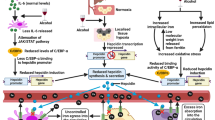Abstract
The aim of this study was to identify apolar aldehydes in liver homogenates from rats with CCl4-induced cirrhosis and, as a corollary, the antioxidant effect of zinc administration. The study was performed in five control rats and in ten cirrhotic rats which were further sub-divided into two groups to receive either a standard diet or one supplemented with zinc. The percentage of hepatic fibrosis, plasma malondialdehyde concentration and alanine aminotransferase activity were measured as well as the following aldehydes: hexanal, octanal, decanal, 2-hexenal, 2-octenal, 2-nonenal, 2,4-heptadienal and 2,4-decadienal. Of the 10 cirrhotic rats, 4 had elevated concentrations of the highly toxic 2,4-dialkenals which coincided with a higher percentage of fibrosis and plasma alanine aminotransferase activity. These aldehydes were not observed in the control group. Zinc administration was associated with a reduction of the hepatic malondialdehyde concentration and an amelioration on the degree of hepatic injury. In conclusion, this study demonstrates the presence of the highly toxic 2,4-dialkenals in hepatic tissue of rats whith CCl4-induced cirrhosis. Results obtained would suggest that these particular aldehydes may be related to the severity of the hepatic injury.
Similar content being viewed by others
References
Poli G, Parola M: Oxidative damage and fibrogenesis. Free Rad Biol Med 22: 287–305, 1997
Stal P: Iron as a hepatotoxin. Dig Dis 13: 205–222, 1997
Nordmann R: Alcohol and antioxidant systems. Alcohol Alcohol 29: 513–522, 1994
Casini A, Ceni E, Salzano R, Biondi P, Parola M, Galli A, Foschi M, Caligiuri A, Pinzani M, Surrenti C: Neutrophil-derived superoxide anion induces lipid peroxidation and stimulates collagen synthesis in human hepatic stellate cells: Role of nitric oxide. Hepatology 25: 361–367, 1997
Suárez-Pinzón WL, Strynadka K, Rabinovitch A: Destruction of rat pancreatic islet β-cells by cytokines involves the production of cytotoxic aldehydes. Endocrinology 137: 5290–5296, 1996
Esterbauer H: Cytotoxicity and genotoxicity of lipid-oxidation products. Am J Clin Nutr 57 (suppl.): 779S–786S, 1993
Poli G, Dianzani MU, Cheeseman K, Slater TF, Lang J, Esterbauer H: Separation and characterization of the aldehydic products of lipid peroxidation estimulated by carbon tetrachloride or ADP-iron in isolated rat hepatocytes and rat liver microsomal suspension. Biochem J 227: 629–638, 1985
Gassó M, Rubio M, Varela G, Cabré M, Caballería J, Alonso E, Deulofeu R, Camps J, Giménez A, Pajares M, Parés A, Mato JM, Rodés J: Effects of S-adenosylmethionine on lipid peroxidation and liver fibrogenesis in carbon tetrachloride-induced cirrhosis. J Hepatol 25: 200–205, 1996
Chojkier M, Houglum K, Solís-Herruzo J, Brenner DA: Stimulation of collagen gene expression by ascorbic acid in cultured human fibroblasts: A role for lipid peroxidation? J Biol Chem 264: 16957–16962, 1989
Camps J, Bargalló T, Giménez A, Alié S, Caballería J, Parés A, Joven J, Masana L, Rodés J: Relationship between hepatic lipid peroxidation and fibrogenesis in carbon tetrachloride-treated rats: Effect of zinc administration. Clin Sci 83: 695–700, 1992
Wilson RL: Zinc and iron in free radical pathology and cellular control. In: C.F. Mills (ed). Zinc in Human Biology. Springer Verlag, London, 1988, pp 147–171
Szymanska JA, Swietlicka EA, Piotrowski JK: Protective effect of zinc in the hepatotoxicity of bromobenzene and acetaminophen. Toxicology 66: 81–91, 1991
Cabré M, Folch J, Giménez A, Matas C, Parés A, Caballería J, Paternáin JL, Rodés J, Joven J, Camps J: Influence of zinc intake on hepatic lipid peroxidation and metallothioneins in alcoholic rats: relationship to collagen synthesis. Int J Vit Nutr Res?65: 45–50, 1995
Esterbauer H, Cheeseman KH: Determination of aldehydic lipid peroxidation products: malondialdehyde and 4-hydroxynonenal. Methods Enzymol 186: 407–421, 1990
Lake BG: Preparation and characterisation of microsomal fractions for studies of xenobiotic metabolism. In: K. Snell and B. Mullock (eds). Biochemical Toxicology (A Practical Approach). IRL Press, Oxford, 1987, pp 183–215
Girona J, La Ville A, Heras M, Olivé S, Masana L: Oxidized lipoproteins including HDL and their lipid peroxidation products inhibit TNF-α secretion by THP-1 human macrophages. Free Rad Biol Med 23: 658–667, 1997
Cabré M, Joven J, Camps J: Specificity of the thiobarbituric acid determination in CCl4-induced hepatic injury in rats. Med Sci Res 21: 55–77, 1993
Kaneko T, Kaji K, Matsuo M: Cytotoxicities of a linoleic acid hydroperoxide and its related aliphatic aldehydes toward cultured human umbilical vein endothelial cells. Chem Biol Interact 67: 295–304, 1988
Müller K, Hardwick SJ, Marchant CE, Law NS, Waeg G, Esterbauer H, Carpenter KLH, Mitchinson MJ: Cytotoxic and chemotactic potencies of several aldehydic components of oxidised low density lipoprotein for human monocyte-macrophages. FEBS Lett 388: 165–168, 1996
Martelli A, Canonero R, Cavanna M, Cedarelli M, Marinari UM: Cytotoxic and genotoxic effects of five n-alkanals in primary cultures of rat and human hepatocytes. Mutat Res 323: 121–126, 1994
Kaneko T, Honda S, Nakano S, Matsuo M: Lethal effects of a linoleic acid hydroperoxide and its autoxidation products, unsaturated aliphatic aldehydes on human diploid fibroblasts. Chem Biol Interactions 63: 127–137, 1987
Nappez C, Battu S, Beneytout JL: Trans, trans-2,4-decadienal: Cytotoxicity and effect on glutathione levels in human erythroleukemia (HEL) cells: Cancer Lett 99: 115–119, 1996
Thomas CE, Jackson RL, Ohlweiler DF, Ku G: Multiple oxidation products in low density lipoproteins induce interleukin-1β release from human blood mononuclear cells. J Lipid Res 35: 417–427, 1994
Hassan G, Moreno S, Massimi M, Di-Biagio P, Stefanini S: Interleukin-1-producing plasma cells in close contact with hepatocytes in patients with chronic active hepatitis. J Hepatol 27: 6–17, 1997
Clément B, Loréal O, Levavasseur F, Guillouzo A: New challenges in hepatic fibrosis. J Hepatol 18: 1–4, 1993
Author information
Authors and Affiliations
Rights and permissions
About this article
Cite this article
Ferré, N., Girona, J., Cabré, M. et al. Hepatic production of apolar aldehydes in rats with carbon tetrachloride-induced cirrhosis. Mol Cell Biochem 198, 57–60 (1999). https://doi.org/10.1023/A:1006998028528
Issue Date:
DOI: https://doi.org/10.1023/A:1006998028528




